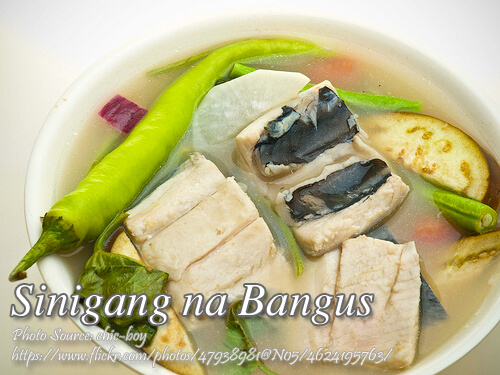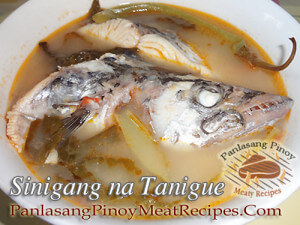Sinigang na bangus or milkfish in sour broth is an all time favorite dish of Filipinos. The sour taste of tamarind gives the distinctive taste of the broth. There are many ways of cooking sinigang and ingredients vary depending on the availability of the ingredients. Ingredients like pork, beef, fish or seafoods are used in cooking siningang. You can also use boneless bangus belly in cooking sinigang if you don’t like to eat the fish while removing the spiny fish bones.
A Delicious Filipino Dish with a Tangy Twist
Also known as milkfish in sour broth, is a beloved and timeless dish in Filipino cuisine. The combination of the tangy tamarind flavor and the succulent bangus fish creates a delightful culinary experience. This recipe blog post will guide you through the process of cooking sinigang na bangus, providing helpful tips along the way.
Preparing the Bangus Fish
To start, you will need to clean and cut the bangus into three pieces. To clean the bangus, remove the scales by using a knife or a fish scaler. Then cut the bangus in three pieces and remove the gills and innards. Wash in running water and drain. Sprinkle salt over the fish to enhance its flavor. This step ensures that the fish is properly seasoned before it is added to the broth.
Creating the Flavorful Broth
In a large casserole, place the tomatoes and onions, and then add four cups of water. Allow the mixture to come to a boil, which will release the flavors of the tomatoes and onions into the broth. This creates a delicious foundation for the sinigang.
Making Tamarind Juice
To achieve the distinctive sour taste of sinigang, you will need to make tamarind juice. Start by boiling a quarter kilogram of tamarind fruit in two cups of water. Once the tamarind fruit has softened, extract the juice by passing it through a sieve. This process separates the pulp and seeds from the flavorful tamarind juice.
Adding the Essential Ingredients
Once the tamarind juice is ready, it’s time to enhance the sinigang by adding the key ingredients. Begin by pouring the tamarind juice into the casserole with the boiled tomatoes and onions. Gently place the milkfish into the broth, allowing it to cook and absorb the flavors.
For added texture and taste, you can include banana blossoms. These flowers not only add a unique element to the dish but also contribute a subtle sweetness that complements the tanginess of the tamarind. Add patis, a Filipino fish sauce, to taste, which enhances the umami flavor of the sinigang.
Simmering and Serving
Allow the milkfish to simmer for three to five minutes, allowing the flavors to meld together. Finally, add kangkong, or water spinach, to the pot. This leafy green vegetable adds freshness and an appealing color to the dish. Once the kangkong is cooked, your dish is ready to be served.
Delight in the Tangy Goodness of Fish Sinigang
Milkfish in sour soup is a comforting and flavorful dish that embodies the essence of Filipino cuisine. The sour broth, combined with the tender milkfish and assorted vegetables, creates a symphony of flavors in every spoonful. This recipe allows you to savor the traditional taste of sinigang na bangus in the comfort of your own home.
Experience the Versatility of Sinigang
While this recipe focuses on using bangus, you can also explore other variations of sinigang. Pork, beef, and different types of seafood can be substituted for the bangus, depending on your preferences and ingredient availability. This versatility allows you to enjoy the dish all year round, adapting it to suit your taste and dietary preferences.
A Nourishing and Wholesome Dish
This dish is not only a delicious culinary experience but also a nourishing and wholesome dish. The combination of fish, vegetables, and tamarind provides essential vitamins and minerals, making it a nutritious addition to your meals. It is a great way to incorporate more fish and vegetables into your diet while indulging in the flavors of Filipino cuisine.
Wrap-Up
Sinigang na bangus is a classic Filipino dish that brings together the tangy flavors of tamarind and the delicate taste of milkfish. With this recipe, you can recreate this beloved dish in your own kitchen. Whether you’re a fan of the traditional bangus or prefer to explore other variations, this is a versatile and satisfying dish that will surely delight your taste buds. So gather your ingredients and embark on a flavorful journey with sinigang na bangus! Want the pork version? Check this sinigang na baboy recipe!
Sinigang na Bangus (Stewed Milkfish in Tamarind)
Ingredients
- 1 pc medium sized bangus
- 4 cups water
- 3 pcs tomatoes sliced
- 1 pc onion sliced
- 1 cup tamarind juice boil 1/4 kilo tamarind fruits to 1 cup water and extract the juice
- 1 cup sliced puso ng saging banana blossom or eggplant
- 1 cup kangkong
- patis or salt to taste
- granulated seasoning or MSG to taste
Instructions
How to cook Sinigang na Bangus
- Clean and cut bangus into 3 pieces. Sprinkle with salt.
- In a caserole, put the tomatoes and onions then boil with 4 cups water.
- To make the tamarind juice, boil raw 1/4 kilo tamarind fruit in 2 cups water. Extract the juice using a sieve.
- Then add the tamarind juice, milk fish, banana blossoms and patis to taste.
- Simmer for 3 to 5 minutes. Then add the kangkong. Serve.
Notes
Cooking Tips:
- Use fresh ingredients: To enhance the flavors of your dish, it's important to use fresh ingredients, particularly the bangus fish and the tamarind. Fresh fish will provide a delicate and tender texture, while fresh tamarind will deliver a vibrant and tangy taste to the broth.
- Adjust the sourness to taste: The sourness level in sinigang can vary depending on personal preferences. If you prefer a more tangy broth, you can increase the amount of tamarind juice. Conversely, if you prefer a milder sourness, you can reduce the amount of tamarind juice or balance it with a bit of sweetness from other ingredients like vegetables or banana blossoms.
- Add vegetables at the right time: Different vegetables have varying cooking times, so it's important to add them to the pot at the appropriate moment. Root vegetables like radishes or taro should be added earlier as they take longer to cook, while delicate greens like kangkong or spinach should be added towards the end to preserve their vibrant color and crisp texture.






Thanks for the info…
Hi there, can I use instant sinigang mix on this sinigang na bangus recipe?
Hi Johnny, yes you can use instant sinigang mix on this sinigang na bangus recipe.